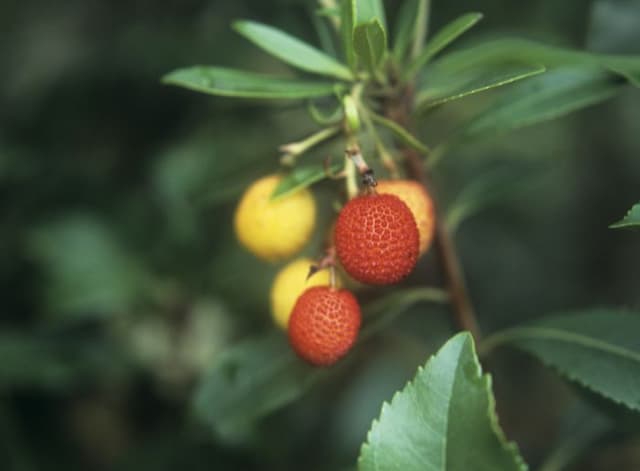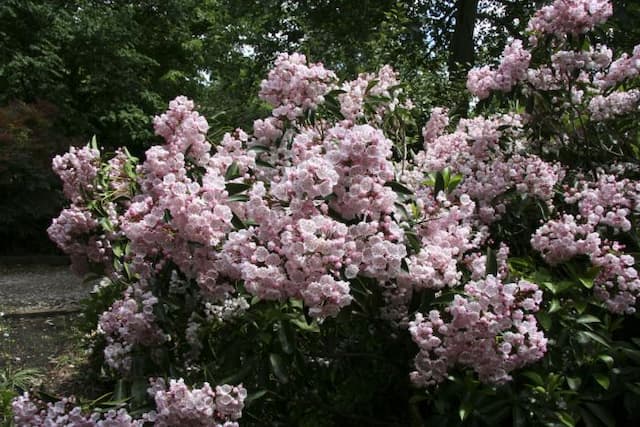Rhododendron Rhododendron 'Renoir'

ABOUT
The Rhododendron 'Renoir' is a flowering shrub known for its striking blooms and lush foliage. It has large, glossy leaves that are evergreen, providing year-round interest in the garden. The leaves are elliptical in shape with a smooth texture and a deep green color that serves as a perfect backdrop for its flowers. This plant is acclaimed for its beautiful flowers that appear in clusters. The flowers of the Rhododendron 'Renoir' are typically bell-shaped with frilly edges, creating a full and romantic display. They are known for their vibrant color, which can range from soft pinks to intense purples, often with delicate speckling on the inside of the petals. The blooms emerge in the spring, covering the plant in a profusion of color and making it a focal point of any garden setting. The Rhododendron 'Renoir' has a bushy habit, with branches that grow densely to give it a full appearance. The overall impression of the Rhododendron 'Renoir' is one of lushness and color, making it a popular choice for gardeners seeking to create an impact with showy flowers and robust evergreen foliage.
About this plant
 Names
NamesFamily
Ericaceae
Synonyms
Azalea
Common names
Rhododendron 'Renoir'
 Toxicity
ToxicityTo humans
Azalea, which includes the 'Renoir' variety, is toxic to humans when ingested. The plant contains a group of toxic compounds known as grayanotoxins. Consumption of any part of an azalea plant can cause symptoms such as nausea, vomiting, weakness, dizziness, difficulty breathing, and a drop in blood pressure. In severe cases, ingesting azalea can lead to a coma or even be fatal.
To pets
Azalea is also toxic to pets, with similar compounds affecting animals in the same way they do humans. If a pet ingests any part of an azalea, symptoms may include vomiting, diarrhea, drooling, weakness, central nervous system depression, changes in heart rate, and possibly seizures. Severe azalea poisoning can be life-threatening and requires immediate veterinary attention.
 Characteristics
CharacteristicsLife cycle
Perennials
Foliage type
Evergreen
Color of leaves
Green
Flower color
Varies
Height
4 feet (1.22 meters)
Spread
4 feet (1.22 meters)
Plant type
Shrub
Hardiness zones
5
Native area
Asia
Benefits
 General Benefits
General Benefits- Enhances Landscape Beauty: Rhododendrons provide vibrant color and visual interest to any garden with their lush foliage and clusters of bright flowers.
- Attracts Pollinators: Rhododendrons are known to attract bees and butterflies, helping to pollinate the surrounding flora.
- Versatility in Landscaping: They can be used in a variety of landscaping designs, from accent plants to hedges, due to their range of sizes and forms.
- Seasonal Interest: With their spring blooms, they offer a seasonal spectacle and are often the first to bring color to a garden after winter.
- Durable and Low Maintenance: Once established, Rhododendrons are quite hardy and require minimal care, making them suitable for gardeners of all skill levels.
- Provides Shade and Shelter: The dense foliage offers shade that can help protect smaller plants, and shelter to birds and beneficial insects.
 Medical Properties
Medical PropertiesThis plant is not used for medical purposes.
 Air-purifying Qualities
Air-purifying QualitiesThis plant is not specifically known for air purifying qualities.
 Other Uses
Other Uses- Rhododendron 'Renoir' can be used as a natural dye for fabrics, giving a range of colors from pink to purple depending on the mordant used.
- The wood of the Rhododendron plant can be utilized in small woodworking projects such as crafting decorative inlays or novelty items.
- The leaves can be part of a compost mix, provided they are used in moderation due to their acidic nature which can alter the pH balance.
- Rhododendron petals can be used in the creation of botanical prints, a form of art where the physical shape and pigment of the petal leaves an impression on paper.
- Thick Rhododendron branches may be used in aquariums to create natural-looking underwater woodscapes after proper treatment.
- Dried Rhododendron petals can be incorporated into potpourri mixes for a subtle fragrance and added aesthetic appeal.
- The plant can be included in a habitat garden to provide shelter and nesting materials for native birds.
- Rhododendron leaves provide a unique organic material for mulch which can suppress weeds and conserve soil moisture around acid-loving plants.
- When pruned properly, Rhododendron branches can be formed into natural trellises or supports for climbing plants in the garden.
- An infusion made from Rhododendron foliage can be used as a natural cleaning agent for garden tools, helping to remove sap and debris.
Interesting Facts
 Feng Shui
Feng ShuiThe plant Rhododendron is not used in Feng Shui practice.
 Zodiac Sign Compitability
Zodiac Sign CompitabilityThe plant Rhododendron is not used in astrology practice.
 Plant Symbolism
Plant Symbolism- Beware: Rhododendrons are often associated with caution or warning due to the poisonous nature of some species.
- Elegance and Wealth: With their lush blooms and association with well-kept gardens, rhododendrons can symbolize elegance and prosperity.
- Survival: As rhododendrons are hardy plants that can grow in challenging conditions, they can also symbolize the ability to thrive in adversity.
- Rejuvenation: Blooming in spring, they represent the idea of new beginnings and the rejuvenation that comes with this season.
 Water
WaterRhododendrons require consistent moisture but should not be overwatered, as this can lead to root rot. They prefer well-draining soil and should be watered deeply when the top inch of soil feels dry to the touch. On average, this may mean watering with about 1 gallon per plant every 7 to 10 days, depending on weather conditions and soil drainage. During periods of drought or extreme heat, increase the frequency of watering to ensure the soil remains moist, but not waterlogged. It's best to water the plant early in the morning to allow excess water to evaporate throughout the day.
 Light
LightRhododendrons, including the 'Renoir' variety, thrive in dappled sunlight or partial shade. They perform best when protected from the harsh afternoon sun, especially in warmer climates. An ideal spot for these plants is under the high, filtered canopy of deciduous trees or on the north side of a building where they can receive bright, indirect sunlight for most of the day. Direct morning sun with afternoon shade can also be ideal to encourage healthy growth without the stress of intense heat.
 Temperature
TemperatureRhododendrons do well in moderate climates and prefer an ideal temperature range between 65°F and 75°F. They can tolerate a maximum temperature of up to 90°F, provided they're not in direct sunlight and have sufficient moisture. These plants can survive minimum temperatures down to about -5°F, but prolonged exposure to extreme cold can be damaging. To encourage optimal growth and flowering, protect them from harsh winter winds and extreme temperature fluctuations.
 Pruning
PruningPruning of Rhododendrons is primarily for shaping and removing dead or diseased wood, and should be done immediately after flowering to avoid cutting off next year's buds. Light pruning can be performed to maintain a dense growth habit and to remove spent flower clusters. Major pruning should be done sparingly, as Rhododendrons are slow to recover from heavy cuts. The best time for any extensive pruning is late winter or early spring, before the plant commences its active growth.
 Cleaning
CleaningAs needed
 Soil
SoilThe Rhododendron 'Renoir', commonly known as the Azalea, thrives in well-draining, acidic soil with a pH between 4.5 to 6.0. A mix of 50% peat moss, 30% pine bark, and 20% perlite or coarse sand would make an ideal soil composition for Rhododendrons. Regular organic matter amendments will help maintain acidity and provide nutrients.
 Repotting
RepottingAzaleas, typically, should be repotted every 2-3 years or when they have become root-bound. Care should be taken not to disturb the roots excessively, and repotting is best done in late winter or early spring, right before new growth begins.
 Humidity & Misting
Humidity & MistingAzaleas prefer moderate to high humidity levels. The best humidity range for these plants is between 50-60%. They can tolerate lower humidity levels, but may require additional care like regular misting to thrive.
 Suitable locations
Suitable locationsIndoor
Place Azalea in bright, indirect light and ensure high humidity.
Outdoor
Plant Azalea in dappled shade, shield from strong wind.
Hardiness zone
5-8 USDA.
 Life cycle
Life cycleAzalea 'Renoir' begins its life cycle as a seed, which, after a period of dormancy and when the conditions are right, will germinate and sprout into a seedling. This seedling will gradually develop into a young plant, experiencing rapid growth and eventually establishing itself with a strong root system and foliage. As the azalea matures, it enters the flowering stage, producing vibrant blooms that are characteristic of the genus Rhododendron, to which it belongs. After pollination, the flowers will give way to seed pods if the conditions allow, and once these mature, they will release seeds, thus continuing the reproductive cycle. Seasonally, the azalea may undergo periods of dormancy, particularly in colder climates where it sheds its leaves and conserves energy until the favorable growing season returns. Throughout its life, the azalea requires careful attention to soil conditions, moisture, and light to thrive and complete its life cycle successfully.
 Propogation
PropogationPropogation time
Spring-Early Summer
Propogation: The Rhododendron 'Renoir', also commonly known as Renoir Rhododendron, is typically propagated in the early spring or late fall. The most popular method of propagation for this variety is softwood cuttings. This involves taking a cutting from the new growth of the plant that is not yet firm. The cutting, usually 4 to 6 inches long, is snipped just below a node, and the lower leaves are removed. The cut end is then dipped in rooting hormone powder to encourage root development and planted in a mixture of peat and perlite that has been moistened. This cutting should then be placed in indirect light and kept at a consistent humidity, often achieved by covering it with a plastic bag or placing it in a propagator. After a few weeks to months, the cutting will develop its own root system and can be transferred to a pot with standard growing medium.









